Content marketing is nothing like it used to be. Suddenly, everyone has access to tools that can spin up dozens of publishable blog posts with a few well-crafted AI prompts. When anyone can scale, you can’t win the battle for clicks and conversions just by speeding up. You need to stand out.
With AI content flooding our feeds every day, I wanted to know how marketing pros are out-competing the tsunami of sameness. So, I asked a cohort of experienced marketers, including some of the best content folks I know, for their most effective content-differentiating tactics.
These pros had some super smart ways to do that—from creating unexpected content types to digging deep for human-inspired insights no LLM has access to. And since most of these pros are on small—or even one-person—teams, every idea is doable for just about every CM.
Contents
- Build a story around original data
- Create non-traditional content types
- Use your voice as a differentiator
- Write for your specific audience
- Share first-hand experience and “provide the receipts”
- Get original quotes from experts
- Bake in relatable examples
- Create with empathy
- Highlight authors over brand
9 ways to differentiate your content
It was interesting that no one was explicitly against the use of AI. In fact, some use AI to support their tactics. But you’ll see that every marketer I talked to focused on adding something AI can’t do—which makes their content more valuable and relevant to the humans they’re hoping to connect with.
1. Build a story around original data
Most marketers have access to the same AI tools that can sift through the same digital archives to unearth existing information. Throw a prompt into Gemini, Perplexity, or others, and you’ll get a dozen recent stats on your topic.
What AI isn’t so great at is generating new data no one else has yet. That’s the gap Ashley Cummings—a prolific freelance SaaS writer and editor—said you can exploit to rise above the AI-generated noise.
“One of the best ways to differentiate right now is with original research,” she said. “Take the time to create a solid study, distribute it to the right audience, and capture insights.”
Ashley told me she writes reports for her clients based on their research, but she also doubles down on this tactic by incorporating it into the content strategy for her own brand.
“For example, I created a 34-page benchmark report for freelance writers and also co-created a report on how marketers are using AI,” she shared.

The report is based on a survey of over 220 content marketers. It tackles topics like how this cohort uses AI in their work and how worried they were that AI could become a competitor.
The data in the report is unique, and it tells a story her followers want to hear. “There’s a lot of generic content out there, and no one needs more of that,” Ashley said. “We need more creative storytelling around hard data that actually brings new insights.”
The best part of Ashley’s strategy is that you can scale it to your resources. A simple poll on LinkedIn generates new, usable data. So does an anonymous questionnaire sent to your customers. If time and budget permit, consider commissioning a large-scale survey about your industry. The data you generate is now yours, and any references to it will lead people back to your platforms.
💡Make AI work for you. Download the Emergency Guide to AI in Marketing and learn how to use it safely and effectively
2. Create non-traditional content types
With so many brands scaling standard SEO posts with AI, it’s nigh on impossible to compete in that space. For Eric Doty, content lead at Dock, the answer is simple: don’t do it.
“I’m trying to do fewer educational, informational things and do more like building things that are more difficult to replace by AI,” he said.
Eric pointed to a growing collection of templates they’ve built as an example. “Templates don’t feel like content, but we’re building things in our product that people can actually use.”
The templates cover many of the most common jobs Dock’s ICP will face, like creating business cases and onboarding customers.

These templates are extremely helpful to Dock’s customers. They’re also built using Dock’s product, so they act like mini-use-case studies.
Here’s the best part, though. These assets are a fantastic SEO play. The query “customer onboarding template” gets a few hundred searches each month—presumably from Dock’s ICP.
Eric used the software he sells to create these templates, but you can swipe this strategy for just about any product. Just think about the tasks your customers have to do repeatedly. Or consider the complex jobs they could use some help with. For example, we’ve created blog post templates, email templates, PPC ad templates, and many others.
The sky’s the limit on the types of content you create. Try bingo cards, calendars, interactive quizzes, timelines, and so on.
Once you have your new and original content, Eric suggests using it in more traditional assets. “We’ve differentiated by having mixed media in a blog post, so it’s not just words, it’s templates, there’s videos, there’s product demos.”
3. Use your voice as a differentiator
Sometimes, it’s not just what you say but how you say it that gets noticed. That’s especially true when everyone is working from the same knowledge base. The critical factor, says Jenna St John, the head of content at Grizzle, is to make sure whatever you share has your spin on it.
“Gen AI can get you ‘good enough’ content, but it’s going to get ignored by humans and then by search engines,” she said. “A distinctive voice and a strong point of view have already demonstrated, across many forms of content, how it can cut through the noise. For better or worse, loud gets heard.”
The marketing newsletter By Popular Demand is a great example of content that leans hard on its voice to stand out in crowded inboxes.
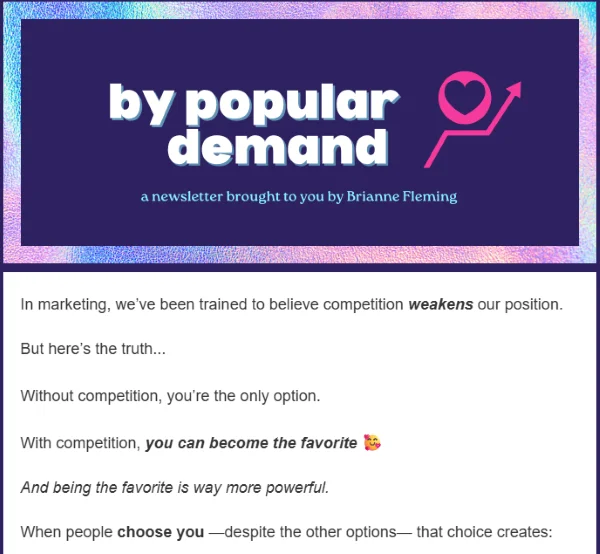
Here are two easy ways to ensure your content is created with your distinctive voice. First, keep a note-taking app handy. Every time you find yourself building an argument in your head about something in your industry, jot it down or record it. Those are the spicy takes that knock people out of their scrolling stupors.
Second, take the topic you’re writing about and explain it to a friend. If you find yourself using different words out loud than you typed, go back and put some more “you” in that post.
“Give your content personality to humanize it and become a reliable, trusted source for readers,” Jenna added. “If your content feels like anyone could write it, then you’re invisible.”
4. Write for your specific audience
Your audience has cultural norms, shared experiences, and a vocabulary that LLMs, or any generically written content, won’t account for. Katrina Balmaceda, director of business development at With Content, says there’s opportunity in those unique quirks.
“Most of With Content’s clients are B2B businesses in Southeast Asia. Over the past eight years, we’ve noticed how a lot of content marketing best practices run up against cultural and traditional norms here,” she explained. “We used to try to convince marketers in our region to adopt these best practices we learn from Western marketers, but we’ve since realized we should be adapting the advice to reality instead.”
Katrina said they localize their content to be more relevant in several ways, including:
- Offering advice that meets social norms: They published this piece on how to write opinionated content for a Southeast Asian audience that “gets their audience thinking without making them feel too uncomfortable…due to unspoken cultural constraints.”
- Share relatable stories: Whenever possible, With Content shares success stories like this one, which feature businesses from Southeast Asia so their audience can connect with them.
- Use relevant metaphors: Metaphors are a shortcut to understanding, but use the right ones for your audience. Katrina said they’re particular about choosing locally relevant metaphors to “help with resonance and identification.”
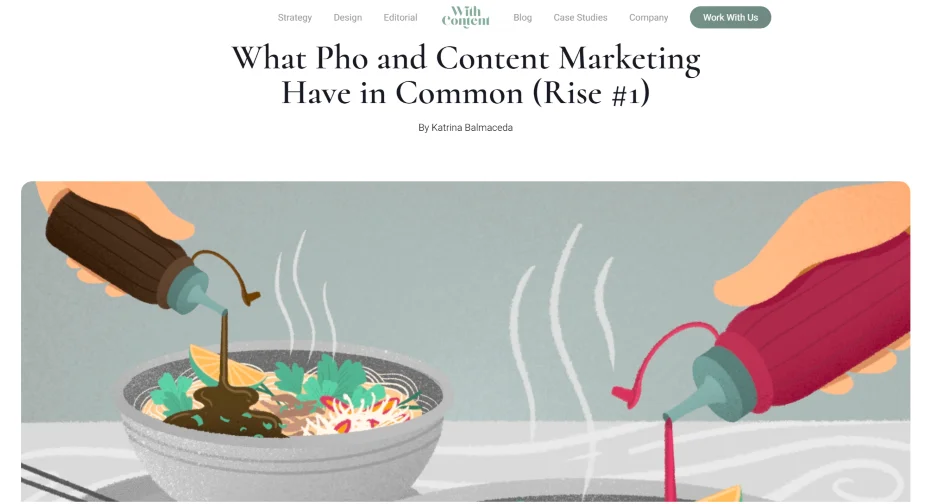
“Since we’ve done this, we’ve noticed our content resonating more,” Katrina said. “More marketers share our ideas with others, and our clients seem more receptive to advice. TL;DR: culture eats strategy for breakfast.”
Jenna offered a similar take. “Content that stands out is and will continue to be rooted in human insight—original thinking, nuance, and deep audience understanding,” she said. “You absolutely must be writing for the reader: what have they looked at before this, what will they look for after it, and what day-to-day problems are they trying to solve? Get in their brains.”
How do you collect this trove of human insight? By speaking with the people you’re surrounded by every day. “Our best-performing content comes from conversations with customers, niche experts, and internal SMEs,” Jenna told me. “We use their language and talk about problems the way they phrase it right from the title and beginning. It’s already a different feel to just blending the top-performing articles in the SERPs.”
5. Share first-hand experience and “provide the receipts”
I’ve always believed that there’s a hierarchy of what makes great content that goes like this:
- Good: “Here’s how you can do a thing.”
- Better: “Here’s how they did a thing.”
- Best: “Here’s how I did a thing.”
Louise Linehan, a content marketer at Ahrefs, also believes that lived experiences are a great way to make your content stand out.
“In terms of differentiating our content from AI-generated, or just generic/formulaic content, we make a concerted effort to include first-hand experience and ‘provide the receipts,’” she said.
For example, when Ahrefs publishes a tool review, it’s not just a book report of what others have already written. “We’ll share screenshots of videos of us actually testing and using the tools, and we make sure to get specific,” Louise said.

Louise gave several other examples of how they build different types of content around first-hand experience:
- Tutorials based on use cases that were successful at Ahrefs.
- Research-based content using their proprietary data.
- Point-of-view articles with their unique take on developing industry news.
I really like this “build in public” idea because it’s easily accessible to every content marketer. Simply switch the framing from third to first person, and include some anecdotes about your personal experience with the topic. I did it recently by testing several AI use cases.
With a little tweak, you can turn this tactic into a way to get AI referral traffic, Louise said. “I think the next step for us, in terms of differentiation, is to get more personalized with the content we create so that we are able to answer more complex AI search queries and turn up in the kinds of specialized conversations that are happening right now.”
6. Get original quotes from experts
I really like when tips from experts are practical and easy to implement (read: not a 26-point strategy). And that’s why I love this one from Kaleigh Moore, an agency owner and experienced content marketer.
“AI can’t conduct interviews, but humans can,” she said. “So get some original quotes from experts.”
Here’s the really cool part: Kaleigh notes that this differentiation strategy comes with a built-in distribution channel. “The bonus is, the people you quote might be willing to share your content, and that’s a nice organic distribution boost!”
Eric Doty said they do this at Dock by harvesting quotes from their podcast, Grow and Tell, and repurposing them in various formats. “[The podcast] is experts that are in our ICP, so like revenue leaders,” he said. “For each show, we have the video itself, and then we’ve made clips for social media and posted those clips on YouTube and our website.”
Eric shared an example of how quotes leveled up a standard SEO article. “In this post about buyer enablement, instead of just cookie-cutter SEO stuff, we’ve also embedded expert quotes, video clips, even our product templates, product examples.”
Here’s what that looks like in a recent Dock blog post:
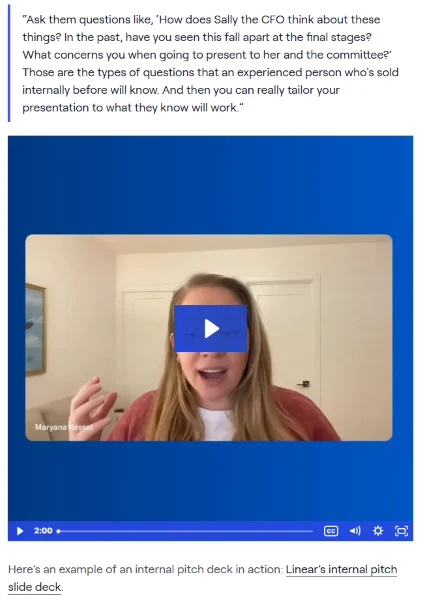
Gathering and organizing expert quotes is a tough job. Colin Campbell, head of content and community at Pixis, told me how he uses AI to do it.
“I’ve recorded every interview me, my content team, and my PR agency have done,” he said. “I transcribed them, then I used an automated workflow and AI to identify potentially quotable sections.”
Colin said he categorizes the quotes and adds them to a table. With the help of another LLM workflow, he references the table when drafting outlines “so at the outline stage, I’m making sure to inform our angle with a real POV and to prove that POV with a quote.”
Kaleigh’s tip is instantly actionable for most of us. You probably have experts in-house you can chat with for their insights. Your customers are another great source. Or, simply search for your specialty on Linkedin and connect with people who are posting about it. Reach out and ask for a couple of quotes for your next article.
7. Bake in relatable examples
For Rease Rios, senior content marketing manager at Postman, there’s a simple way to best boring content, especially when it’s created by AI.
“AI can help you with a lot of aspects of writing, but I’ve always found that the right example can elevate a piece of content, and examples are not something AI excels at,” Rease said.
One of the most important roles of a content marketer is to make complex concepts understandable. Rease says that this is where an ideal example really shines. “I work with very technical topics, so when I write or edit, I look for ways to take a step back and connect with the reader through an example that will resonate,” she explained. “Often, this means finding an example that works with a much broader (and potentially less technical) audience.”
I think this tactic works similarly to Louis’ tip on using first-person experience. You’re packaging a concept in a relatable story to make it more memorable and understandable. And in both cases, it’s something you can do better than AI.
Eric Doty has an interesting application of this strategy. He built this gallery of sales assets to help inspire his customers to create their own.
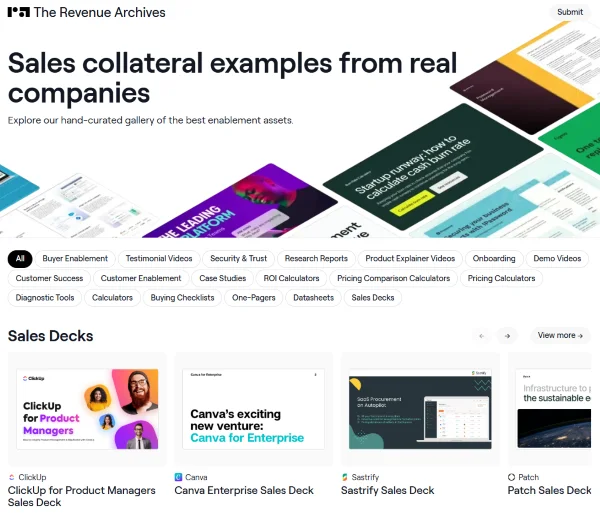
“It’s one thing to write best practices; it’s another to curate examples. It’s effortful work that’s still not extremely easy for LLMs to replicate,” Eric said.
“Solid, relatable examples are a great differentiator,” Rease added. “Examples are your chance to get into the mindset of the readers and consider ‘what would make this click for them?’”
Real-world examples are best. But when they aren’t readily available, try some hypotheticals that bring your point home. Just remember what Katrina said about relatability. If you’re selling to blue-collar tradespeople, a pithy anecdote about a stock trader may not land.
🛑 Boring copy doesn’t convert in calls to action, either. Get The 42 Best Call to Action Phrases Ever (& Why They Work)
8. Create with empathy
Empathy is often either treated as a hollow buzzword or confused with being nice. In reality, empathy is a learned skill that’s essential for any effective communicator, and as Stephanie Yoder, director of content at Rebrandly, explained, it’s a valuable tool for connecting with your audience in the age of AI.
“You need to be empathetic to your readers, which is something AI cannot do,” Stephanie said. “An increasing number of companies are churning out endless pages of AI-generated content in an arms race to the bottom. That means content made with actual human beings in mind (as opposed to bots) will stand out even more. There is a golden opportunity for brands willing to double down on genuinely helpful content.”
In the context of content creation, empathy means understanding the real problem your customer is trying to solve. The old adage is to “sell the hole, not the drill.” Meaning, promote the solution, not the product. I’d say take that a step further and empathize with the pride of hanging a shelf yourself—then write content that speaks to that.
For a big brand, The Home Depot does a great job of empathizing with its customers. Their taglines “You can do it. We can help” and “How doers get more done” speak directly to our sense of accomplishment instead of “selling the drill.”

There are lots of opportunities to show empathy for your readers in long-form content, too. Name your target audience in the introduction, include pain points in your H2s, and add an inside joke or two.
The point, according to Stephanie, is to make sure and include a people-first perspective in all of your content, no matter how it’s created. “This doesn’t mean you can’t use AI to speed up your content creation process,” she said. “But a human must absolutely be in the loop at every stage of the process, preserving the humanity and actual utility of your content.”
9. Highlight authors over brand
Colin Campbell, the head of content and community at Pixis who gave us the tip earlier on managing expert quotes, has thought a lot about how the challenge of standing out in an increasingly crowded space.
“When everybody’s using the same LLMs, which all have access to the same information to produce content on the same topics, no amount of editing the outputs will help create a differentiated final product,” he noted. “The only reliable way to create differentiated content now is to curate inimitable inputs.
Collin mentioned four “buckets” of such inputs:
- Opinions
- Experiences
- Proprietary data
- Identity
Other content marketers I spoke to had already explored the first three. So, I was interested in diving into the fourth. “I do believe users will care more and more about who wrote the content they consume,” Collin told me. “Just look at the rise of Substack and individual influencers as ‘thought leaders.’”
We already see this play out all over LinkedIn. Scroll long enough, and you’ll see individuals’ accounts getting much more engagement than the brands they work for. The trick is parlaying that personal following into views and visits on your content.
Rand Fishkin is a great example of how an author can build credibility that outshines brands to out-compete generic content.
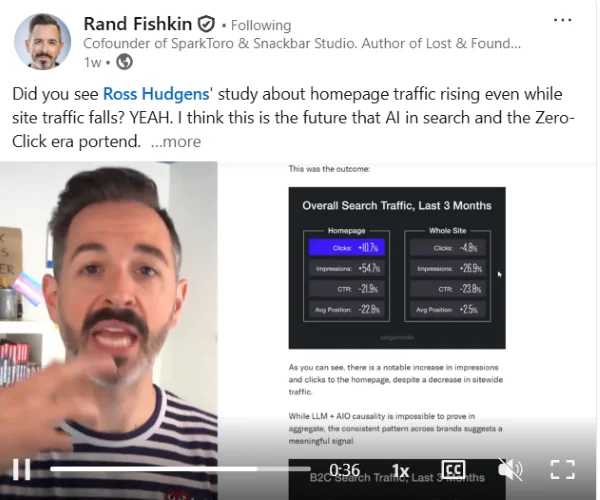
You don’t need to be as prolific on social media as Rand to use Colin’s advice. Try highlighting your author’s credibility in your blog posts. Have them write in the first person where applicable. And start an employee influencer program to help your team members grow their brand—and credibility—with your audience.
Future-proof your content marketing strategy
As content marketers, we’ve all seen an incredible amount of change in recent months. It seems like our playbooks get rewritten every few weeks. And even the most experienced among us are constantly “just figuring it out.”
As unsteady as some of this feels, this pro advice shows there are some constants you can rely on to work:
- Know your customers better than your competitors do
- Use that knowledge to create content with empathy for your audience
- Do things others don’t to stand out
- Place your people out front so followers and buyers know they’re hearing from humans
Keep these themes in mind, and you’ll future-proof your content strategy, no matter how smart AI gets.







